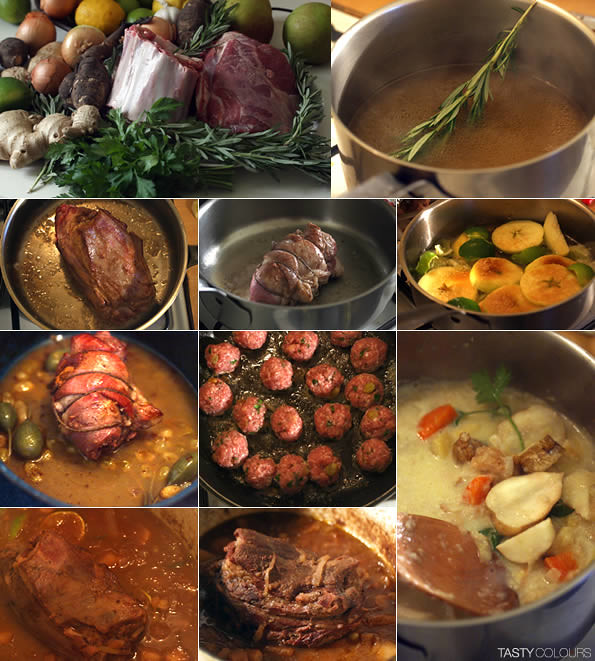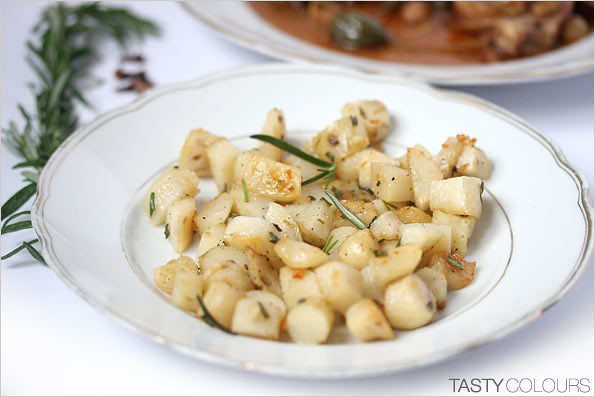Hello, let’s
start today with discovering Old Polish cuisine, as announced in my previous long post. You know what I was doing last Saturday and Sunday? I spent entire Saturday chopping, peeling, slicing, dicing, cooking and trying
to understand how to deal with ancient recipes from the 17th century
written in archaic Polish language. I cooked
a few dishes. I discovered new food compositions and I will share those recipes
with you in upcoming posts, one by one. Have a look at the teaser below:
When I
finished my cooking, it was already dark. Because I photograph my meals only
using day light, I got up early on Sunday, did the session and shot the
pictures in bizarre positions which made my back hurt like hell.
Below is the reprint of the first
Polish cookbook by Stanisław Czerniecki. It is not
an easy “cookbook”. It does not provide for any measurements or proportions so,
really, you have to rely on your own imagination, taste and some historical
knowledge which fortunately is presented in an interesting and very well written introduction of professor Jarosław Dumanowski. The book, published recently within a series called “Monumenta Poloniae
Culinaria” - is an elegant and very nicely published work of 240 pages done by the Wilanów Museum in Warsaw, the Nicolas Copernicus University in Toruń and Lubomirski Foundation.
There are 333 recipes, which are short, even extremely brief (“take an animal,
cut it into smaller parts, cook it, and in the middle of cooking add this and
that”). Fortunately the book contains a glossary of old Polish culinary terms and quite a lot of reproductions of old
paintings and pictures which somehow guide you.
Remember that
the recipes presented below reflect my personal attempts to test ancient, Old
Polish cuisine rather than an attempt to reconstruct an authentic taste and flavor
which – as I wrote in my last post – probably would not be edible according to
our present taste. Those cooks of the 17th century used to add too much
pepper, sugar and acids. I started with the dish which I liked most -
braised lamb roll - which I decided to do at the last minute, after I
discovered that I had some spare, cheap lamb’s meat, perfect for braising. The combination
of acid and salty capers with sweet raisins and vinegar, enhanced by home made veal stock was tasty, in particular with an ancient root vegetable called Jerusalem artichokes fried with goose grease, rosemary and garlic. Jerusalem
artichoke was very common in Poland 200 or 300 years ago but disappeared
completely from Polish tables and menus. I tried it for the first time two years ago. A week ago, I was given one kilogram of these
interesting roots by my friend, who writes an excellent blog about wines. The
Jerusalem artichoke arrived in Old Poland, to the best of my knowledge, from America
and became popular later on. Nowadays you will not buy it in the groceries. People who have family houses in the countryside say
that it grows widely in many locations, it is extremely expansive as a
plant, so it is not so difficult to find.
Sweet and Sour Braised Lamb Rolls with Capers and Raisins
(słodko – kwaśna rolada jagnięca z
kaparami i czosnkiem)
For this type
of dish you can use a cheaper and greasier type of meat like, for example, ribs
- once you separate the meat from the bones, you can roll the meat and tight it
with a string; such a meat in my opinion is best when braised slowly so it
melts into your mouth. However, you can use other meats like poultry, goose,
duck or veal. Pork would be fine as well, although don't forget that in 17th and 18th century Old Polish
cuisine pork was not
popular at all. My addition to the recipe has been homemade veal stock as well as wine, to
enhance the taste. It was pretty delicious!
Makes 1 roll, serves 2 small portions
300 g boneless
lamb's brisket (or any other type of
meat which will be good for rolls – not necessarily lamb)
100 ml veal stock (optional)
200 ml stock (meat or vegetable)
Clarified
butter / goose grease for frying
3 tablespoons white wine vinegar
100 ml white wine
12 caper berries or 30 capers
1 garlic clove, chopped
1 handful raisins (soaked in some liquid or stock
beforehand)
1 tea spoon brown sugar
½ teaspoon ground
cinnamon
Pepper
Salt
String
Rub the meat (at
room temperature) with salt and pepper on both sides and with garlic on the
inner side. Roll the meat tightly and knot it with string. In a sticky
saucepan, warm the grease (clarified butter) and fry the meat on all sides. Don't burn it. Put into a small skillet. Deglaze the pan with white
wine and pour the liquid into the skillet. Pour the stock, veal stock and braise
until soft (in my case, it took nearly 2 hours – the meat was of a rather poor quality - it needs long, slow cooking). Occasionally check if the
juices did not evaporate, pour some juices with a ladle over the
meat. When the meat is nearly soft, add caper berries, raisins with the soaking
liquid, cinnamon, vinegar. Play with you taste and adjust accordingly. At the
end, add sugar, salt and pepper. My guess that this dish should be sweet and sour.
Cut into slices, and serve with sauteed topinambur. If you do not have any,
make a pea puree or millet (potatoes were not eaten in Poland in the 17th century).
Jerusalem
Artichoke with Rosemary and Garlic
(topinambur z rozmarynem i czosnkiem)
Serves
2 small portions
250 g Jerusalem
artichoke (topinambour), delicately peeled and washed and diced (if you do
this in advance, keep the vegetable in water with some vinegar to prevent it
from darkening)
1 hipped tablespoon, fresh chopped rosemary
2 small garlic
cloves, chopped
100 ml white
wine
1-2 tablespoons goose grease or clarified butter
Salt
Pepper
Heat a saucepan. Once hot, add the grease and
Jerusalem artichoke (if kept in water before, dry it out with a paper towel).
Sauté for one minute over a quite high heat and add garlic, sauté for one more
minute being careful - do not burn the garlic. Add wine and cook over a quite
high heat until wine evaporates - approximately 5-10 minutes. In the meantime,
add rosemary. Once the Jerusalem
artichoke is quite soft, add salt and pepper to taste. Serve hot as a side dish to your meat.
Bon appétit!












5 comments:
hah, staropolskie przepisy... w tym cudownym kraju jagnięcina jest OGROMNĄ rzadkością, a jeśli już się znajdzie to ceny są zabójcze. Ech.
I see you have managed to decipher those recipes quite well. What puzzles me however, is such a small number of responses to your posts. Have you blocked adding comments, or is it only salads, sweets and mama's cooking that our foodblog viewers are looking for?
Anyhow, if you happen to be in my area, just come over without invitation. We've loads of lamb on this island, so there'll be enough shanks, legs, racks and shoulders to recreate every ancient recipe you can unearth. We're also well supplied in Jerusalem artichoke department, so no compromises there.
Wow, Sweet and Sour Braised Lamb Rolls with Capers and Raisins looks amazing!
Here you could find some attempts to receipes from Compendium &c. However there are only interpretations, in fact we have tried to reconstruct old taste and form. I must say that all dishes have been edible, even according to our present taste ;)
http://www.kujawskaszlachta.pl/kulinaria.html
Thanks for sharing the recipes, I will have a look!
Post a Comment